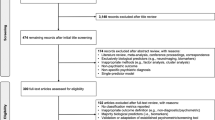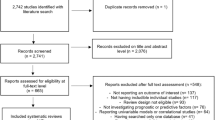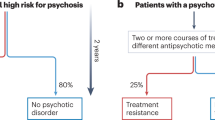Abstract
Biomarkers are the measurable characteristics of an individual that may represent risk factors for a disease or outcome, or that may be indicators of disease progression or of treatment-associated changes. In general, the process by which biomarkers, once identified, might be translated into clinical practice has received scant attention in recent psychiatric literature. A body of work in diagnostic development suggests a framework for evaluating and validating novel biomarkers, but this work may be unfamiliar to clinical and translational researchers in psychiatry. Therefore, this review focuses on the steps that might follow the identification of putative biomarkers. It first addresses standard approaches to characterizing biomarker performance, followed by demonstrations of how a putative biomarker might be shown to have clinical relevance. Finally, it addresses ways in which a biomarker-based test might be validated for clinical application in terms of efficacy and cost-effectiveness.
This is a preview of subscription content, access via your institution
Access options
Subscribe to this journal
Receive 12 print issues and online access
$259.00 per year
only $21.58 per issue
Buy this article
- Purchase on Springer Link
- Instant access to full article PDF
Prices may be subject to local taxes which are calculated during checkout




Similar content being viewed by others
References
Rush AJ, Trivedi MH, Wisniewski SR, Nierenberg AA, Stewart JW, Warden D et al. Acute and longer-term outcomes in depressed outpatients requiring one or several treatment steps: a STAR*D report. Am J Psychiatry 2006; 163: 1905–1917.
Kaitin KI . Deconstructing the drug development process: the new face of innovation. Clin Pharmacol Ther 2010; 87: 356–361.
Perlis RH, Ostacher MJ, Patel JK, Marangell LB, Zhang H, Wisniewski SR et al. Predictors of recurrence in bipolar disorder: primary outcomes from the systematic treatment enhancement program for bipolar disorder (STEP-BD). Am J Psychiatry 2006; 163: 217–224.
Keefe RS, Bilder RM, Davis SM, Harvey PD, Palmer BW, Gold JM et al. Neurocognitive effects of antipsychotic medications in patients with chronic schizophrenia in the CATIE Trial. Arch Gen Psychiatry 2007; 64: 633–647.
Biomarkers Definitions Working Group.. Biomarkers and surrogate endpoints: preferred definitions and conceptual framework. Clin Pharmacol Ther 2001; 69: 89–95.
Kraemer HC, Stice E, Kazdin A, Offord D, Kupfer D . How do risk factors work together? Mediators, moderators, and independent, overlapping, and proxy risk factors. Am J Psychiatry 2001; 158: 848–856.
Baron RM, Kenny DA . The moderator-mediator variable distinction in social psychological research: conceptual, strategic, and statistical considerations. J Pers Soc Psychol 1986; 51: 1173–1182.
Hampel H, Frank R, Broich K, Teipel SJ, Katz RG, Hardy J et al. Biomarkers for Alzheimer's disease: academic, industry and regulatory perspectives. Nat Rev Drug Discov 2010; 9: 560–574.
Greden JF, Albala AA, Haskett RF, James NM, Goodman L, Steiner M et al. Normalization of dexamethasone suppression test: a laboratory index of recovery from endogenous depression. Biol Psychiatry 1980; 15: 449–458.
Arana GW, Baldessarini RJ, Ornsteen M . The dexamethasone suppression test for diagnosis and prognosis in psychiatry. Commentary and review. Arch Gen Psychiatry 1985; 42: 1193–1204.
Young E, Korszun A . Sex, trauma, stress hormones and depression. Mol Psychiatry 2010; 15: 23–28.
Heim C, Newport DJ, Mletzko T, Miller AH, Nemeroff CB . The link between childhood trauma and depression: insights from HPA axis studies in humans. Psychoneuroendocrinology 2008; 33: 693–710.
Anonymous. Table of Valid Genomic Biomarkers in the Context of Approved Drug Labels. 2010: Available from: http://www.fda.gov/Drugs/ScienceResearch/ResearchAreas/Pharmacogenetics/ucm083378.htm.
Northridge ME . Public health methods—attributable risk as a link between causality and public health action. Am J Public Health 1995; 85: 1202–1204.
Manolio TA, Collins FS, Cox NJ, Goldstein DB, Hindorff LA, Hunter DJ et al. Finding the missing heritability of complex diseases. Nature 2009; 461: 747–753.
Thomson Reuters Clinical Editorial Staff. Carbamazepine. 2010. Physician's Desk Reference [serial on the Internet].
Chung WH, Hung SI, Hong HS, Hsih MS, Yang LC, Ho HC et al. Medical genetics: a marker for Stevens-Johnson syndrome. Nature 2004; 428: 486.
Wray NR, Yang J, Goddard ME, Visscher PM . The genetic interpretation of area under the ROC curve in genomic profiling. PLoS Genet 2010; 6: e1000864.
So HC, Sham PC . A unifying framework for evaluating the predictive power of genetic variants based on the level of heritability explained. PLoS Genet 2010; 6: e1001230.
Cook NR . Statistical evaluation of prognostic versus diagnostic models: beyond the ROC curve. Clin Chem 2008; 54: 17–23.
Diamond GA . What price perfection? Calibration and discrimination of clinical prediction models. J Clin Epidemiol 1992; 45: 85–89.
Fava M, Rush AJ, Alpert JE, Balasubramani GK, Wisniewski SR, Carmin CN et al. Difference in treatment outcome in outpatients with anxious versus nonanxious depression: a STAR*D report. Am J Psychiatry 2008; 165: 342–351.
Eichler K, Puhan MA, Steurer J, Bachmann LM . Prediction of first coronary events with the Framingham score: a systematic review. Am Heart J 2007; 153: 722–731, 31 e1-8.
Ridker PM, Buring JE, Rifai N, Cook NR . Development and validation of improved algorithms for the assessment of global cardiovascular risk in women: the Reynolds Risk Score. JAMA 2007; 297: 611–619.
Cook NR . Use and misuse of the receiver operating characteristic curve in risk prediction. Circulation 2007; 115: 928–935.
Pencina MJ, D'Agostino Sr RB, D'Agostino Jr RB, Vasan RS . Evaluating the added predictive ability of a new marker: from area under the ROC curve to reclassification and beyond. Stat Med 2008; 27: 157–172; discussion 207-12.
Kathiresan S, Melander O, Anevski D, Guiducci C, Burtt NP, Roos C et al. Polymorphisms associated with cholesterol and risk of cardiovascular events. N Engl J Med 2008; 358: 1240–1249.
Perlis RH, Ostacher MJ, Miklowitz DJ, Hay A, Nierenberg AA, Thase ME et al. Clinical features associated with poor pharmacologic adherence in bipolar disorder: results from the STEP-BD study. J Clin Psychiatry 2010; 71: 296–303.
Seddon JM, Reynolds R, Maller J, Fagerness JA, Daly MJ, Rosner B . Prediction model for prevalence and incidence of advanced age-related macular degeneration based on genetic, demographic, and environmental variables. Invest Ophthalmol Vis Sci 2009; 50: 2044–2053.
Ioannidis JP . Why most discovered true associations are inflated. Epidemiology 2008; 19: 640–648.
Ising M, Lucae S, Binder EB, Bettecken T, Uhr M, Ripke S et al. A genomewide association study points to multiple loci that predict antidepressant drug treatment outcome in depression. Arch Gen Psychiatry 2009; 66: 966–975.
Steyerberg EW, Vickers AJ, Cook NR, Gerds T, Gonen M, Obuchowski N et al. Assessing the performance of prediction models: a framework for traditional and novel measures. Epidemiology 2010; 21: 128–138.
Wisniewski SR, Rush AJ, Nierenberg AA, Gaynes BN, Warden D, Luther JF et al. Can phase III trial results of antidepressant medications be generalized to clinical practice? A STAR*D report. Am J Psychiatry 2009; 166: 599–607.
Serna MC, Cruz I, Real J, Gasco E, Galvan L . Duration and adherence of antidepressant treatment (2003 to 2007) based on prescription database. Eur Psychiatry 2010; 25: 206–213.
Haga SB . Impact of limited population diversity of genome-wide association studies. Genet Med 2010; 12: 81–84.
Kassirer JP, Pauker SG . The toss-up. N Engl J Med 1981; 305: 1467–1469.
Gail MH, Brinton LA, Byar DP, Corle DK, Green SB, Schairer C et al. Projecting individualized probabilities of developing breast cancer for white females who are being examined annually. J Natl Cancer Inst 1989; 81: 1879–1886.
Mealiffe ME, Stokowski RP, Rhees BK, Prentice RL, Pettinger M, Hinds DA . Assessment of clinical validity of a breast cancer risk model combining genetic and clinical information. J Natl Cancer Inst 2010; 102: 1618–1627.
Braff DL, Freedman R . Clinically responsible genetic testing in neuropsychiatric patients: a bridge too far and too soon. Am J Psychiatry 2008; 165: 952–955.
Driessen E, Hollon SD . Cognitive behavioral therapy for mood disorders: efficacy, moderators and mediators. Psychiatr Clin North Am 2010; 33: 537–555.
Simon GE, Perlis RH . Personalized medicine for depression: can we match patients with treatments? Am J Psychiatry 2010; 167: 1445–1455.
Kirchheiner J, Brockmoller J . Clinical consequences of cytochrome P450 2C9 polymorphisms. Clin Pharmacol Ther 2005; 77: 1–16.
Perlis RH, Ganz DA, Avorn J, Schneeweiss S, Glynn RJ, Smoller JW et al. Pharmacogenetic testing in the clinical management of schizophrenia: a decision-analytic model. J Clin Psychopharmacol 2005; 25: 427–434.
Lebovic GS, Hollingsworth A, Feig SA . Risk assessment, screening and prevention of breast cancer: a look at cost-effectiveness. Breast 2010; 19: 260–267.
Kopans DB . The 2009 U.S. Preventive Services Task Force guidelines ignore important scientific evidence and should be revised or withdrawn. Radiology 2010; 256: 15–20.
Thrall JH . US Preventive Services Task Force recommendations for screening mammography: evidence-based medicine or the death of science? J Am Coll Radiol 2010; 7: 2–4.
DeAngelis CD, Fontanarosa PB . US Preventive Services Task Force and breast cancer screening. JAMA 2010; 303: 172–173.
Rutigliano MJ . Cost effectiveness analysis: a review. Neurosurgery 1995; 37: 436–43; discussion 43-4.
Perlis RH, Patrick A, Smoller JW, Wang PS . When is pharmacogenetic testing for antidepressant response ready for the clinic? A cost-effectiveness analysis based on data from the STAR*D study. Neuropsychopharmacology 2009; 34: 2227–2236.
Introduction to cost-effectiveness analysis (CEA) [database on the Internet]. Available from: http://www.herc.research.va.gov/methods/cea.asp.
Kirchheiner J, Rodriguez-Antona C . Cytochrome P450 2D6 genotyping: potential role in improving treatment outcomes in psychiatric disorders. CNS Drugs 2009; 23: 181–191.
Perlis RH . Cytochrome P450 genotyping and antidepressants. Bmj 2007; 334: 759.
Kraft JB, Peters EJ, Slager SL, Jenkins GD, Reinalda MS, McGrath PJ et al. Analysis of association between the serotonin transporter and antidepressant response in a large clinical sample. Biol Psychiatry 2007; 61: 734–742.
Freidlin B, McShane LM, Korn EL . Randomized clinical trials with biomarkers: design issues. J Natl Cancer Inst 2010; 102: 152–160.
Daban C, Martinez-Aran A, Cruz N, Vieta E . Safety and efficacy of Vagus Nerve Stimulation in treatment-resistant depression. A systematic review. J Affect Disord 2008; 110: 1–15.
Epstein RS, Moyer TP, Aubert RE, O Kane DJ, Xia F et al. Warfarin genotyping reduces hospitalization rates results from the MM-WES (Medco-Mayo Warfarin Effectiveness study). J Am Coll Cardiol 2010; 55: 2804–2812.
Simon RM, Paik S, Hayes DF . Use of archived specimens in evaluation of prognostic and predictive biomarkers. J Natl Cancer Inst 2009; 101: 1446–1452.
Salloway S, Sperling R, Gilman S, Fox NC, Blennow K, Raskind M et al. A phase 2 multiple ascending dose trial of bapineuzumab in mild to moderate Alzheimer disease. Neurology 2009; 73: 2061–2070.
Simon R . The use of genomics in clinical trial design. Clin Cancer Res 2008; 14: 5984–5993.
Mandrekar SJ, Sargent DJ . Clinical trial designs for predictive biomarker validation: theoretical considerations and practical challenges. J Clin Oncol 2009; 27: 4027–4034.
Manji H . Serotonin Transporter Promoter Polymorphisms and Placebo Response. 2001. NIMH New Clinical Drug Evaluation Unit Meeting. NCDEU: Phoenix, AZ, 2001.
Fava M . A randomized, controlled trial of buspirone, melatonin, or the combination for anxious major depressive disorder. American Psychiatric Association: San Francisco, CA, 2009.
Simon R, Maitournam A . Evaluating the efficiency of targeted designs for randomized clinical trials. Clin Cancer Res 2004; 10: 6759–6763.
Johnson BA, Ait-Daoud N, Chamindi S, Roache JD, Javors MA, Wang X et al. Pharmacogenetic approach at the serotonin transporter gene as a method to reduce the severity of drinking alcohol. Am J Psychiatry 2011; 168: 265–275.
Wakelee H, Kernstine K, Vokes E, Schiller J, Baas P, Saijo N et al. Cooperative group research efforts in lung cancer 2008: focus on advanced-stage non-small-cell lung cancer. Clin Lung Cancer 2008; 9: 346–351.
Acknowledgements
I thank Shaun Purcell, PhD, and Pamela Sklar, MD, PhD, for helpful discussion. This work was supported by R01 MH086026 and by the Stanley Center for Psychiatric Research.
Author information
Authors and Affiliations
Corresponding author
Ethics declarations
Competing interests
Dr Perlis has received consulting fees and royalties from Concordant Rater Systems and consulting fees from Proteus Biomedical, RIDVentures and Genomind.
Rights and permissions
About this article
Cite this article
Perlis, R. Translating biomarkers to clinical practice. Mol Psychiatry 16, 1076–1087 (2011). https://doi.org/10.1038/mp.2011.63
Received:
Revised:
Accepted:
Published:
Issue Date:
DOI: https://doi.org/10.1038/mp.2011.63
Keywords
This article is cited by
-
Multi-criteria decision making to validate performance of RBC-based formulae to screen \(\beta\)-thalassemia trait in heterogeneous haemoglobinopathies
BMC Medical Informatics and Decision Making (2024)
-
Discriminant analysis and binary logistic regression enable more accurate prediction of autism spectrum disorder than principal component analysis
Scientific Reports (2022)
-
Predicting change in diagnosis from major depression to bipolar disorder after antidepressant initiation
Neuropsychopharmacology (2021)
-
Advances toward precision medicine for bipolar disorder: mechanisms & molecules
Molecular Psychiatry (2021)
-
Calprotectin, an available prognostic biomarker in systemic sclerosis: a systematic review
Clinical Rheumatology (2021)



